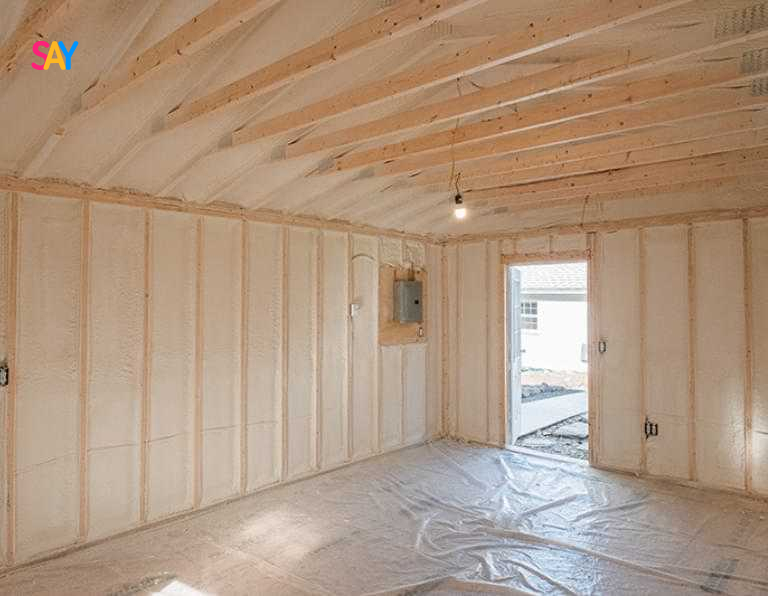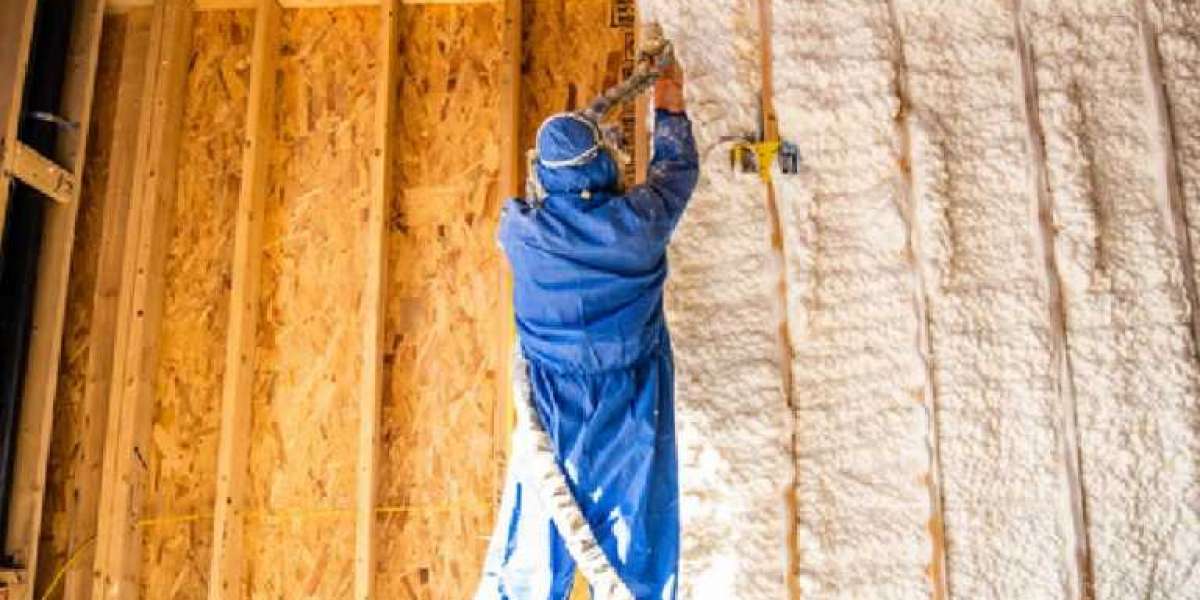Releigh Spray foam insulation improves temperature control in warehouses by creating a seamless thermal and air barrier that limits heat transfer and air infiltration. This insulation method minimizes temperature swings, reduces HVAC system workload, and helps stabilize internal climate regardless of outdoor conditions. It performs particularly well in large, open buildings where managing heat and airflow is more difficult due to high ceilings, metal components, and external exposure.
By sealing gaps and insulating surfaces with high R-value material, raleigh spray foam insulation reduces energy waste and improves operational consistency. Warehouses benefit from greater temperature uniformity, reduced condensation risks, and enhanced structural durability. This article details how spray foam outperforms conventional insulation methods, explains different foam types, and presents key metrics and decision-making considerations for warehouse applications.
Key Benefits of Spray Foam Insulation in Warehouses
Benefit | Description |
Airtight Seal | Prevents uncontrolled airflow, minimizing temperature loss and drafts. |
High R-Value per Inch | Delivers superior thermal resistance, maximizing performance in tight spaces. |
Moisture Barrier | Controls humidity levels, reducing condensation and mold development. |
Structural Strength | Increases rigidity of walls and ceilings, helping resist vibration or movement. |
Reduced HVAC Load | Lowers heating and cooling demands by improving energy retention. |
Noise Dampening | Absorbs airborne sound, especially in busy loading and production areas. |
Temperature Stability | Maintains consistent temperatures across wide floor areas and tall spaces. |
Long-Term Cost Savings | Decreases utility costs and prolongs HVAC system life through improved efficiency. |
Bonus Tip
Closed-cell spray foam is especially effective in high-moisture environments or metal warehouses where added structural support is needed.
Types of Spray Foam Used in Warehouses
Type | R-Value per Inch | Expansion Rate | Best Use Case | Moisture Resistance | Application Flexibility |
Closed-Cell Spray Foam | 6.0–7.5 | Low | Metal buildings, cold storage, humid climates | High | High |
Open-Cell Spray Foam | 3.5–4.0 | High | Interior partitions, roof cavities with low moisture risk | Low | Moderate |
Technical Performance Data
Metric | Closed-Cell Foam | Open-Cell Foam |
R-Value per Inch | 6.5–7.5 | 3.6–4.0 |
Permeability | 1 perm (low) | 10 perms (high) |
Compressive Strength | 25–30 psi | 4–6 psi |
Air Barrier at 1" Thickness | Yes | No |
Water Resistance | High | Low |
Application Thickness (avg.) | 1–2 inches (multiple layers) | 3–4 inches |
Thermal Drift Over Time | Low | Moderate |
Fire Rating Compatibility | Class I with barrier | Class I with barrier |
Bonus Tip
After application, use thermal imaging or blower door testing to confirm full coverage and identify missed areas that may lead to heat loss.
Comparison with Other Warehouse Insulation Options
Insulation Type | R-Value per Inch | Air Seal | Moisture Barrier | Suitability for Large Spaces | Fire Retardant Required | Installation Complexity |
Spray Foam (Closed Cell) | 6.5–7.5 | Yes | Yes | High | Yes | Moderate to High |
Fiberglass Batt | 3.0–4.0 | No | No | Medium | Yes | Low |
Mineral Wool | 3.3–4.2 | No | Some | Medium | Yes | Moderate |
Rigid Foam Board | 5.0–6.5 | Limited | Yes | Medium | Sometimes | Moderate |
Reflective Foil | 1 | No | No | Low | No | Low |
Things to Consider Before Making a Decision
- Building Type: Steel-framed or metal panel warehouses gain extra value from closed-cell foam due to added stiffness and water vapor resistance.
- Climate Zone: In colder or humid climates, choose insulation that delivers both high R-values and low permeability.
- Roof and Wall Structure: Corrugated or uneven surfaces are more effectively sealed with spray foam than with rigid or batt materials.
- Access and Timing: Schedule installation early in construction or before rack systems are installed to allow clear access to all surfaces.
- Fire Code Compliance: Many codes require ignition barriers or thermal coverings for exposed spray foam. Ensure foam products and coatings are compatible.
- Budget Forecasting: Although spray foam has higher initial costs, calculate ROI based on expected energy savings and longer HVAC lifespan.
- Future Modifications: Closed-cell foam can be harder to remove or modify. Evaluate whether walls or ceilings might need future access.
Bonus Tip
For unconditioned storage areas adjacent to climate-controlled zones, consider applying spray foam to shared partitions to prevent energy bleed.

Common Questions
Is spray foam safe for warehouse use?
Yes. When fully cured, it’s stable, chemically inert, and widely approved under commercial fire codes when paired with ignition barriers.
Does spray foam need ongoing maintenance?
No maintenance is required beyond visual inspection. Damage or degradation is rare unless exposed to physical impact or UV light.
Can I apply spray foam without professional help?
No. Commercial-scale applications require specialized training, protective gear, and spray equipment for proper installation and safety compliance.
What’s the average lifespan of warehouse spray foam insulation?
Properly installed spray foam can last 30 to 50 years without losing insulating performance or structural integrity.
Can it be applied over existing insulation?
In some cases, yes. Closed-cell foam can be applied over other materials if they are dry, intact, and securely attached.
Topic FAQ
How does spray foam insulation control temperature better than traditional options?
It combines insulation and air sealing in one application, which reduces unwanted heat exchange and stabilizes indoor conditions.
Which type of spray foam is best for humid warehouse environments?
Closed-cell spray foam. Its low permeability helps block moisture, reducing risks of mold and corrosion in high-humidity areas.
Will spray foam lower my energy costs in a large facility?
Yes. Warehouses benefit from reduced HVAC runtime and more consistent climate control, especially in temperature-sensitive storage areas.
Is it suitable for retrofitting older warehouse buildings?
Yes. Spray foam can be installed in existing structures with proper surface preparation. It’s especially effective on older metal walls and ceilings.
Does spray foam meet local fire safety regulations?
Most commercial-grade products are compliant when installed with the correct ignition or thermal barrier coatings as required by code.
Make the Right Decision
Spray foam insulation provides warehouse operators with tighter climate control, lower energy consumption, and improved building performance. Its ability to insulate and seal in a single application offers long-term value, especially in metal or temperature-sensitive facilities.
Before moving forward, assess the specific needs of your warehouse—consider the building’s design, regional climate, equipment load, and long-term operational costs. Align your insulation strategy with these conditions to ensure lasting performance and compliance with local regulations.





